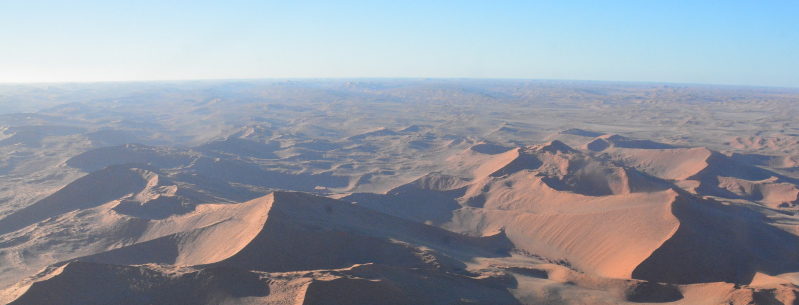Africa’s Secret Gem
Nowhere in Africa, or even the world, can you find such surreal environments and wildlife as in Namibia. Yet its colonial architecture, excellent transport infrastructure, and English speaking locals make it a very accessible destination that can be explored to suit your taste. Namibia is ideal for those who want to self-drive – the roads are long, straight and never-ending and the views are spectacular! Likewise, fully escorted tours are easy to arrange and hassle-free. There is accommodation to suit all tastes.

Namibia, with its golden deserts, silvery salt-pans, azure skies, and year-round sunshine is rightly described as ‘Africa’s secret gem’.
Nature has given Namibia, a land of seemingly endless panoramas of space and freedom, some priceless gifts.
Natural splendors
Here you can watch the animals gathering around the waterholes in the arid Etosha National Park, view the spectacular Fish River Canyon, or marvel at the wind-sculpted sand dunes of the Namib, the oldest desert in the world.
In spite of its vastness – four times the size of the UK – Namibia has a well-developed transport and tourism infrastructure with more kilometers of road per head of population than anywhere in the world, and driving is on the left. The country can be explored by hiring a car, luxury coach, four-wheel-drive vehicles and light aircraft.
Excellent choice of accommodation
Hotels and game lodges are of international standards, but a special feature of Namibia is its network of comfortable guest farms, where visitors join their hosts for meals and become involved in the rural way of life.
Must-see attractions
Namibia affords you the opportunity to see animals gathering around waterholes in the arid Etosha National Park, view the Fish River Canyon, or marvel at the wind-sculpted sand dunes of the Namib, the oldest desert in the world.
Etosha Pan
Set in the heart of the Etosha National Park, this shallow depression is about the size of Holland. Formerly an inland sea, the pan still attracts large wildlife such as elephants and lions because of the waterholes and springs, despite the environment.
This huge clay pan is perhaps the main reason Namibia has such a draw to its surreal environment.
Sossusvlei
The dramatic landscapes in this region are home to the side-winding snake, found amongst the ever-changing sand dunes – which at 300 meters tall are the largest in the world.
Fish river canyon
One of nature’s largest creations, the 160km long canyon is almost 500 million years old. Formed by the collapse of the valley bottom and water erosion, the canyon can get as deep as 550 meters and is matched only by the Grand Canyon in America.
Caprivi Strip
The Caprivi Strip is the narrow protrusion of Namibian land that extends eastwards for about 280 miles, between Botswana to the south, Angola and Zambia to the north, and the Okavango Region to the west. In contrast to much of Namibia, The Caprivi Strip stretches as far as the Zambezi River in the east and so contains wetland areas rich in wildlife.

When to visit
Namibia is a year-round holiday destination, but there are particular times of the year when the game viewing is at its best, and others which are to be avoided by visitors averse to extremes of temperature.
Some like it hot
You can travel to Namibia at any time of year. The best time, however, is the period from April to June, when the temperatures are around 25°C during the day and the sky is clear blue. The nights are cool, and ideal for a good night’s sleep.
The dry winter months July to September are also a good time to visit this desert country and are the best time for the game. The temperature during the day stays above 20°C, but on the central plateau and in the Namib Desert the nights can be freezing.
The summer months December to February are very hot. The Namibians like to travel to the cooler coastal resorts, in particular Swakopmund. Here, heavy fogs often smother the coastline until late morning when they dissipate in the heat. At this time temperatures often climb up to the 40°C mark.
For birders the warmer months of October to March are best because residents, as well as migrant birds, are around. However, it must be noted that there are hundreds of resident species, so they are also prolific in the dry winter months when temperatures are cooler.
